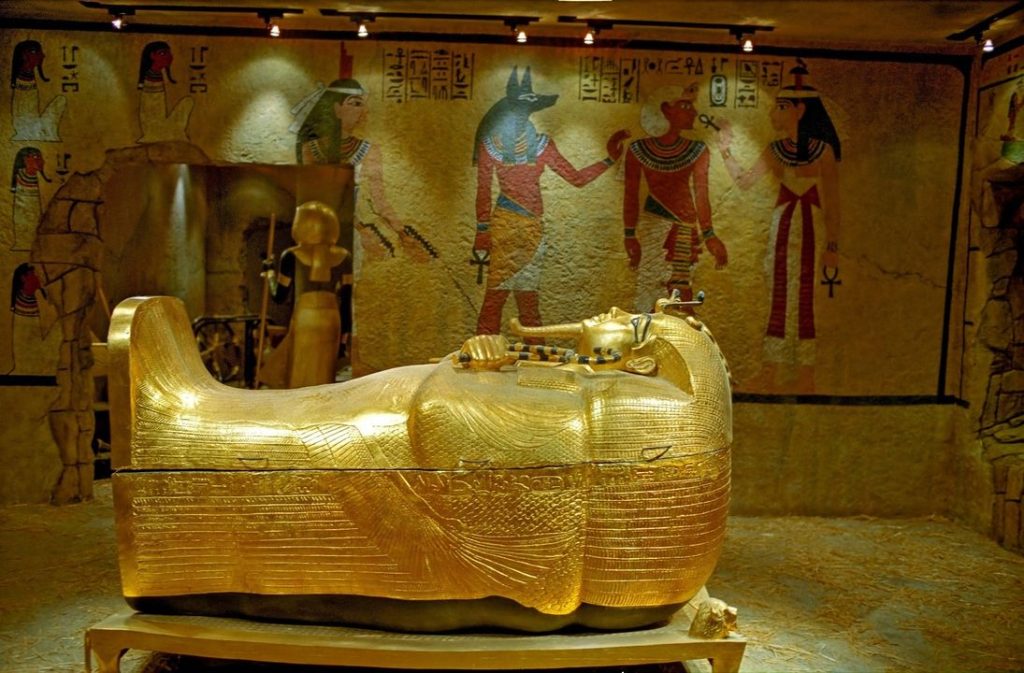A sarcophagus is a stone coffin or a container designed to hold a coffin. While the earliest sarcophagi were specifically intended to encase coffins, the term has evolved to describe any stone coffin placed above ground. The origins of stone sarcophagi trace back to the pharaohs of Egypt’s 3rd dynasty, who ruled from approximately 2686 to 2613 B.C.E. These structures played a crucial role in ancient Egyptian burial practices, reflecting both religious beliefs and artistic craftsmanship.

Ancient Egyptians believed in an afterlife, viewing the sarcophagus as an eternal dwelling place for the deceased. Pharaohs and wealthy individuals were often buried in sarcophagi adorned with intricate carvings and vivid paintings, symbolizing their status and ensuring their legacy endured. Early sarcophagi were architecturally inspired by the palaces of the pharaohs, mirroring the grandeur and design of royal residences. Because Egyptians believed that remembering a person’s name ensured their continued existence in the afterlife, the sarcophagus typically displayed the name of the individual interred within. Additionally, external decorations frequently chronicled the deceased’s achievements, celebrating their accomplishments and preserving their memory for eternity. These adornments often included a list of food offerings to sustain the soul, a symbolic door allowing the spirit to pass between realms, and carved eyes enabling the deceased to observe the world beyond the grave. Over time, sarcophagi evolved in design, with carvings shaped to resemble the person within, aligning with the contours of the mummy’s body. Some sarcophagi were large enough to house multiple coffins, and many featured pitched roofs, enhancing their structural integrity. Starting in the late thirteenth century, sarcophagi were mounted on sleds or runners, allowing them to be more easily transported to burial sites.
The sarcophagus served as a key element of the elaborate burial process practiced by ancient Egyptians. Central to their beliefs was the conviction that life continued beyond death. Preparing the deceased for this journey involved embalming the body to preserve it, followed by wrapping it in linens through a meticulous process known as mummification. The mummy was then placed within a mummy case, a protective box that fit snugly between the mummy and the coffin. The coffin itself was subsequently enclosed within the sarcophagus, though in some instances, the sarcophagus functioned as the coffin, eliminating the need for an additional container. This multi-layered burial process reflected the Egyptians’ deep respect for the afterlife and their desire to safeguard the physical body, which they believed was essential for the soul’s continued existence.
Many sarcophagi have remained hidden for millennia, only to be rediscovered through modern archaeological endeavors. One notable example occurred in July 2018 when Egyptian archaeologists unearthed a massive 30-ton sarcophagus of black granite at a construction site in Alexandria, Egypt. Inside, they found the remains of three mummies, initially believed to be military officers due to the sarcophagus’s imposing size and craftsmanship. However, DNA analysis later revealed that one of the individuals was a woman, challenging earlier assumptions. Unlike the elaborately decorated sarcophagi of the upper class, this sarcophagus bore no inscriptions and contained few burial goods, aside from a small gold artifact and three sheets of gold. The absence of identifying markers and personal belongings has left archaeologists with limited clues regarding the identities and social status of the individuals within, presenting a compelling mystery that continues to intrigue researchers.
While ancient Egypt is most closely associated with sarcophagi, these stone coffins were also used in ancient Rome and Greece, where they served both practical and symbolic purposes. In Roman and Greek cultures, sarcophagi were often adorned with elaborate carvings depicting mythological scenes, historical events, and personal achievements, reflecting the deceased’s beliefs and social standing. The craftsmanship and artistic detail found on these sarcophagi provide valuable insights into the cultural and religious practices of these ancient civilizations. Furthermore, the treasures discovered within—ranging from jewelry and coins to pottery and weapons—offer glimpses into the daily lives, trade networks, and technological advancements of the time.
The enduring fascination with sarcophagi stems not only from their historical significance but also from the mysteries they continue to reveal. Each discovery represents a tangible connection to the past, shedding light on ancient beliefs about life, death, and the afterlife. The intricate carvings and paintings that adorn these stone coffins serve as visual narratives, conveying stories that have transcended centuries. Moreover, advancements in scientific analysis, including DNA testing and radiocarbon dating, have allowed researchers to glean new information about the individuals buried within, providing insights into their health, ancestry, and social status.
Beyond their historical and archaeological value, sarcophagi hold a profound cultural significance, embodying humanity’s enduring quest to understand the mysteries of life and death. The belief in an afterlife, shared by many ancient civilizations, underscores a universal desire to ensure that one’s legacy endures beyond the physical realm. The elaborate burial rituals associated with sarcophagi reflect a deep respect for the deceased, emphasizing the importance of preserving both the body and the memory of the individual. This reverence for the dead is evident in the meticulous craftsmanship and artistic detail that characterize these stone coffins, which were designed to provide comfort and protection for the soul’s journey into the afterlife.
In modern times, the discovery and study of sarcophagi continue to captivate both scholars and the public, offering a window into ancient cultures and their beliefs about life, death, and the afterlife. Each sarcophagus represents a unique piece of history, preserving the stories of individuals who lived thousands of years ago. As archaeologists continue to unearth these ancient artifacts, they not only expand our understanding of the past but also inspire a deeper appreciation for the rich cultural heritage that has shaped human civilization. The legacy of sarcophagi endures as a testament to the ingenuity, artistry, and spiritual beliefs of the ancient world, reminding us of the timeless human quest to leave a lasting mark on the world, both in life and beyond.





